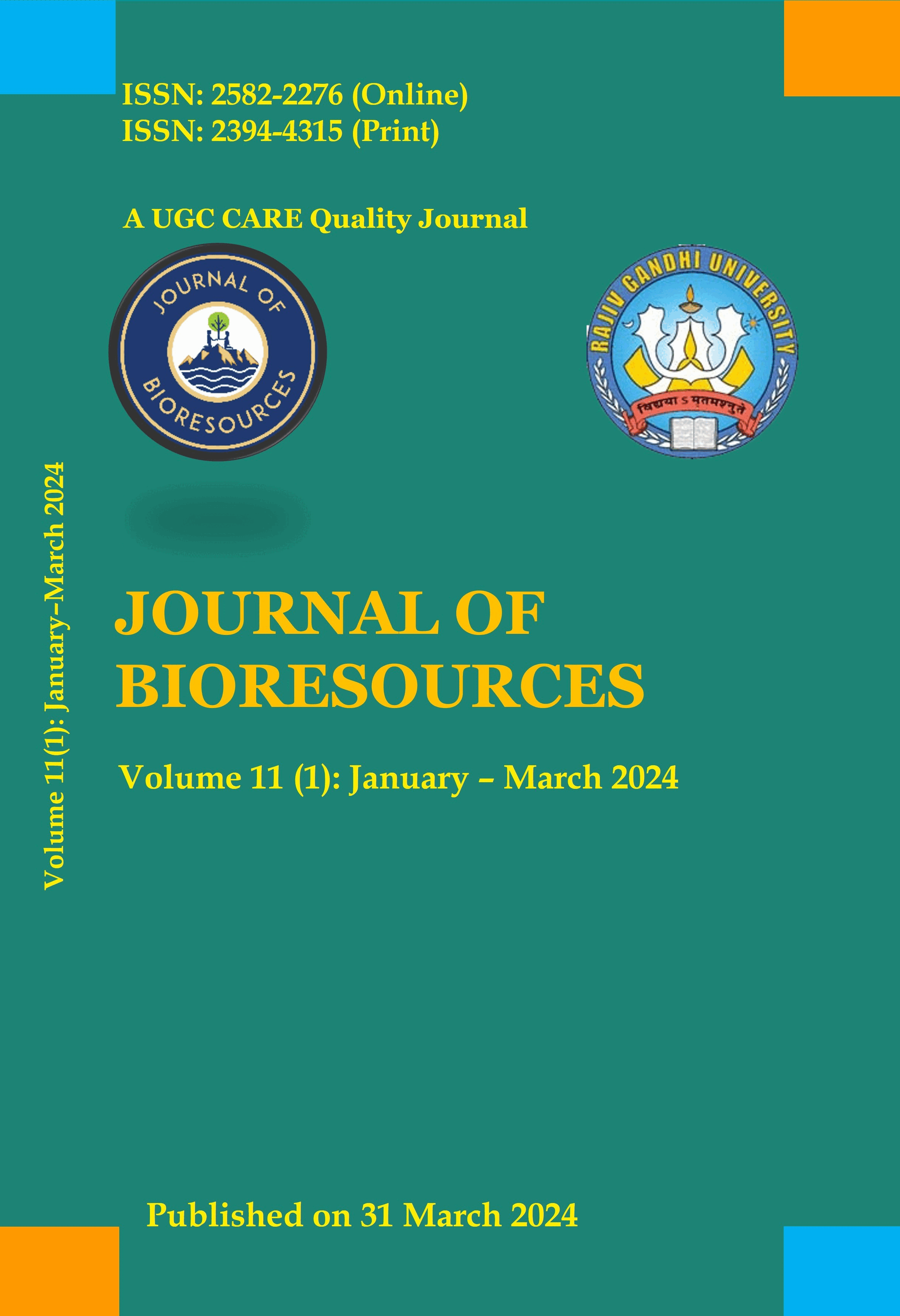Article Preview

Journal of Bioresources
Volume: 11 (1) : January-March 2024

Extended distribution record of two threatened species of Impatiens (Balsaminaceae) from Arunachal Pradesh, India
Abstract
Two threatened species of Impatiens namely I. sikkimensis and I. tuberculata were recorded here as a new record for the flora of Arunachal Pradesh, India. Both the species were earlier known only from Sikkim in India. Detail description from live material and coloured illustrations for easy identification are provided.
Keywords: Balsam Impatiens New record T hreatened species; Arunachal Pradesh
Introduction
Impatiens belonging to the family Balsaminaceae is one of the largest genera of Angiosperm having more than 1000 species (Mabberley, 2008; Bhaskar, 2012; Yu, 2012; Gogoi et al., 2018, 2021), distributed in the tropical and subtropical regions of the Old World as well as in the northern temperate regions (Fischer, 2004; Mabberley, 2008). The genus is known to have five distinctive diversity hotspots i.e. Tropical Africa, Sino-Himalayan region, Southern part of India, Madagascar and South-East Asia (Toppin, 1920; Grey-Wilson, 1980; Bhaskar and Razi, 1981; Chen, 2001; Gogoi et al., 2018). The habitat requirement of the Impatiens species is very much specific and prefer to grow in cool, moist, mountainous habitats and is the reason why most of the species were endemic to particular locality.
During a recent plant expedition tour to Tawang and other adjoining areas of Arunachal Pradesh in August 2023, many species of Impatiens were collected. After critical examination of the specimen and thorough scrutiny of literature (Lamarck, 1778; Hooker, 1905; Grey-Wilson, 1991; Chakrabarty, 2009; Govaerts and Chakrabarty, 2011; Gogoi et al., 2018, 2018a, 2021; Borah et al., 2019; Wangchuk et al., 2020) two of the specimens were identified as Impatiens sikkimensis Govaerts & Chakrab. and Impatiens tuberculata Hook.f. & Thomson.
The present discovery of I. sikkimensis is very important from the conservation point of view as the species is endemic to Sikkim (Grey-Wilson, 1991; Chakrabarty, 2009; Gogoi et al., 2018a) and is endangered due to restricted distribution with decreasing population (Gogoi et al., 2021). Recently this species was discovered from Zhemgang district of Bhutan by Wangchuk et al. (2020). The other species I. tuberculata is recorded only from Sikkim in India other than Bhutan and China, and also considered as endangered and no recent collection was observed from India (Gogoi et al., 2018, 2021).
Hence, it is reported here as new addition to flora of Arunachal Pradesh, India and this information shall be important for planning conservation strategies of both these two threatened species. A detail description along with coloured photographic illustration are provided for easy identification of the species in the field.
Section Snippets
Materials and methods
Extensive field survey was conducted to different parts of Tawang district in the month of August, 2023 to collect different species of Impatiens. The species collected were dissected, photographed, descriptions were prepared and finally put up on herbarium sheets following the method of Jain and Rao (1976). The voucher specimens were deposited in herbarium of Arunachal Pradesh Regional Centre of Botanical Survey of India (ARUN). The specimens were identified consulting the relevant literatures as mentioned above.
Result
3.1. Taxonomic
Treatment Impatiens sikkimensis Govaerts & Chakrab., Rheedea 21: 173 (2011); I. lutea Hook.f., Rec. Bot. Surv. India 4: 18 (1905), nom. illeg.; Grey-Wilson in Grierson & Long, Fl. Bhutan 2: 96. 1991; Vivek. & al. in Hajra & al, Fl. India 4: 176. 1997. I. humilis Hook.f., Hooker's Icon. Pl. 30: t. 2964 (1911). (Figure 1) Annual herb, 20–60 cm tall, sparsely branched, hairy on upper parts. Leaves evenly distributed on the stem, alternate; petiole 0.5–1.4 cm; blade sparsely hairy, elliptic to ovate, 2.5–10 × 1–4 cm, apex acuminate, base cuneate, margin crenate, setose between the teeth, extrafloral nectaries absent. Inflorescence 1–3 flowers fascicle, axillary, peduncle 1–2 cm long. Flowers yellow with red spots on middle; bract ovate, to 0.4 cm long, hairy, apex acuminate; pedicel 1.5–2 cm long, hairy. Lateral sepals 2, widely ovate, green, dorsally hairy, 0.7–0.9 × 0.8–1 cm, apex cuspidate. Lower sepal yellow, navicular, gradually tapering in to a spur; mouth to about 1 cm long, beaked; spur yellow to yellowish green, to 1.5 cm long, coiled or curved. Dorsal petal yellow, widely ovate, 0.9–1.1 × 1–1.3 cm, beak absent. Lateral united petals yellow with greenish splash at the base and red blotch on throat, bilobed, upper (basal) lobe unevenly ovate, 0.7–0.8 × 0.9–1.1 cm, not clawed, apex obtuse to emarginate; lower (distal) lobe unevenly dolabriform, 0.5–0.6 × 1.2–1.4 cm, apex notched, auricle absent. Stamens 5, encircled the ovary, to 0.4 cm long, filaments greenish. Capsule linear, green, 3–4 cm long. Seeds oblong.
Conclusion
The present study documents the extended geographical distribution of Impatiens sikkimensis and I. tuberculata from Tawang district of Arunachal Pradesh. Both the species were earlier reported only from the state of Sikkim in India. Though quite good population of I. sikkimensis were observed but I. tuberculata was recorded only from single location.
Acknowledgement
The authors are thankful to Dr. A.A. Mao, Director, Botanical Survey of India, Kolkata, for logistic support. The authors are also thankful to Dr. Rajib Gogoi, Scientist, Botanical Survey of India, Sikkim Himalayan Regional Centre for help in the identification of the species. The author SB is thankful to the Head, Department of Botany, Gauhati University for logistic and support.
Author’s contributions
Collection of the sample and photography was performed by KC. The identification of species and draft was prepared by SB. Both the authors (KC & SB) checked and finalised the manuscript.
Conflict of interests
Authors have no conflict of interests.
References
Bhaskar V. 2012. Taxonomic monograph on Impatiens L. (Balsaminaceae) of Western Ghats, South India: The key genus for endemism. Bangalore: Centre for plant Taxonomic Studies.
Borah S, Sarma J and Gogoi R. 2019. Impatiens kamrupana (Balsaminaceae): a new species from Assam, India. Phytotaxa 395(1): 035– 040
Chakrabarty T. 2009. Checklist of the genus Impatiens L. (Balsaminaceae) for Sikkim State. Journal of Economic Taxonomic Botany 33(1): 205–215.
Fischer E. 2004. Balsaminaceae. In: Kubitzki, K. (eds.) The Families and Genera of Vascular Plants VI. Springer Verlag, Berlin. Pp. 20–25. https://doi.org/10.1007/978-3-662-07257-8_4
Gogoi R, Sherpa N and Rai S. 2021. Wild Balsam of Darjeeling and Sikkim Himalaya: A Pictorial Handbook. Botanical Survey of India, Kolkata and Directorate of Cinchona and Other Medicinal Plants, West Bengal. Pp. 1– 295.
Gogoi R, Borah S, Dash SS and Singh P. 2018. Balsams of Eastern Himalaya – A Regional Revision. Botanical Survey of India, Kolkata. Pp. 1–216.
Gogoi R, Kumar A and Adamowski W. 2018. Note on Impatiens sikkimensis (Balsaminaceae) and its recollection after a century. Nelumbo 60(1): 23–25.
